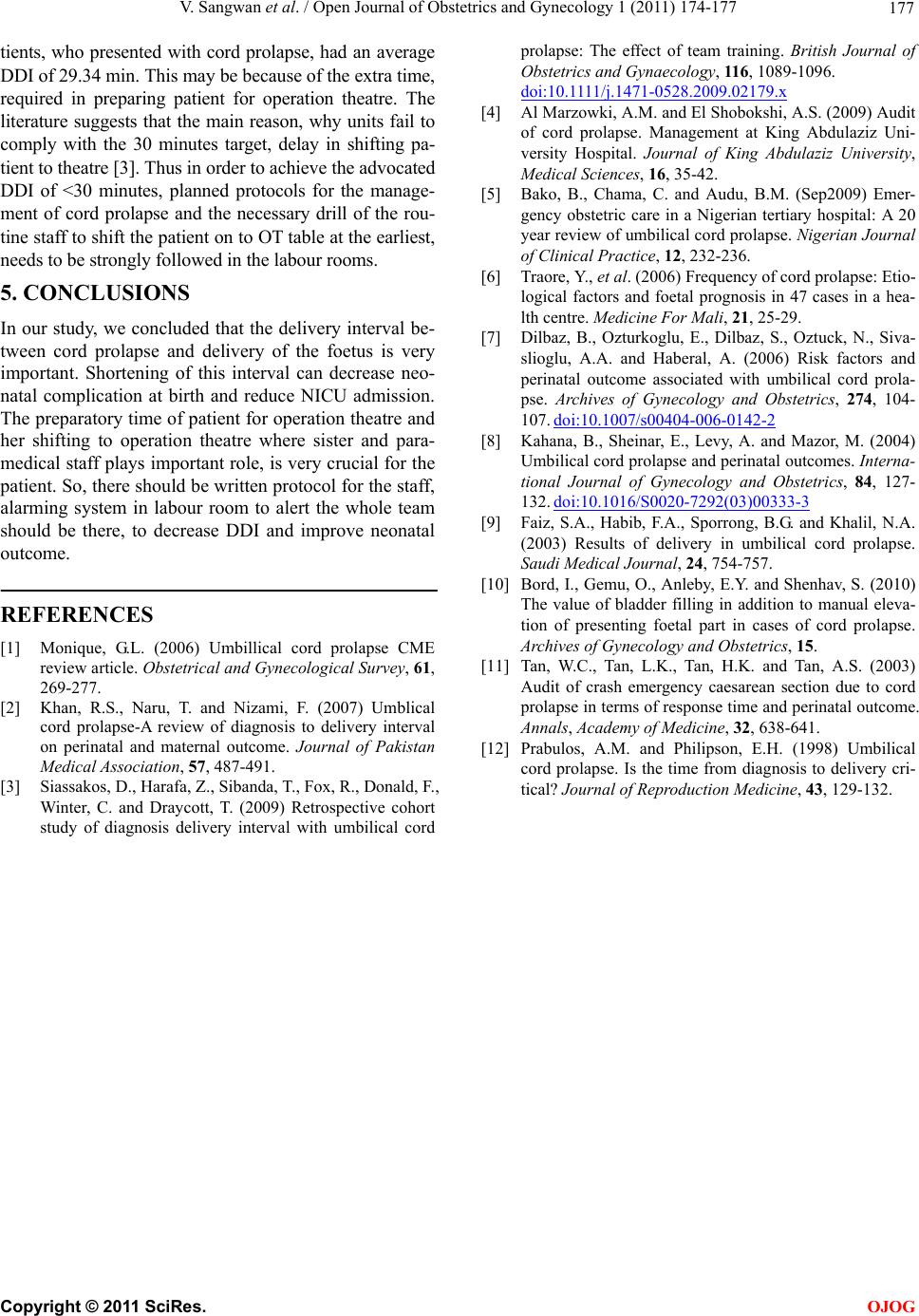
V. Sangwan et al. / Open Journal of Obstetrics and Gynecology 1 (2011) 174-177
Copyright © 2011 SciRes.
177
tients, who presented with cord prolapse, had an average
DDI of 29.34 min. This may be because of the extra time,
required in preparing patient for operation theatre. The
literature suggests that the main reason, why units fail to
comply with the 30 minutes target, delay in shifting pa-
tient to theatre [3]. Thus in order to achieve the advocated
DDI of <30 minutes, planned protocols for the manage-
ment of cord prolapse and the necessary drill of the rou-
tine staff to shift the patient on to OT table at the earliest,
needs to be strongly followed in the labour rooms.
OJOG
5. CONCLUSIONS
In our study, we concluded that the delivery interval be-
tween cord prolapse and delivery of the foetus is very
important. Shortening of this interval can decrease neo-
natal complication at birth and reduce NICU admission.
The preparatory time of patient for operation theatre and
her shifting to operation theatre where sister and para-
medical staff plays important role, is very crucial for the
patient. So, there should be written protocol for the staff,
alarming system in labour room to alert the whole team
should be there, to decrease DDI and improve neonatal
outcome.
REFERENCES
[1] Monique, G.L. (2006) Umbillical cord prolapse CME
review article. Obstetrical and Gynecological Survey, 61,
269-277.
[2] Khan, R.S., Naru, T. and Nizami, F. (2007) Umblical
cord prolapse-A review of diagnosis to delivery interval
on perinatal and maternal outcome. Journal of Pakistan
Medical Association, 57, 487-491.
[3] Siassakos, D., Harafa, Z., Sibanda, T., Fox, R., Donald, F.,
Winter, C. and Draycott, T. (2009) Retrospective cohort
study of diagnosis delivery interval with umbilical cord
prolapse: The effect of team training. British Journal of
Obstetrics and Gynaecology, 116, 1089-1096.
d oi: 10. 1111/j .14 71-0528.2009.02179.x
[4] Al Marzowki, A.M. and El Shobokshi, A.S. (2009) Audit
of cord prolapse. Management at King Abdulaziz Uni-
versity Hospital. Journal of King Abdulaziz University,
Medical Sciences, 16, 35-42.
[5] Bako, B., Chama, C. and Audu, B.M. (Sep2009) Emer-
gency obstetric care in a Nigerian tertiary hospital: A 20
year review of umbilical cord prolapse. Nigerian Journal
of Clinical Practice, 12, 232-236.
[6] Traore, Y., et al. (2006) Frequency of cord prolapse: Etio-
logical factors and foetal prognosis in 47 cases in a hea-
lth centre. Medicine For Mali, 21, 25-29.
[7] Dilbaz, B., Ozturkoglu, E., Dilbaz, S., Oztuck, N., Siva-
slioglu, A.A. and Haberal, A. (2006) Risk factors and
perinatal outcome associated with umbilical cord prola-
pse. Archives of Gynecology and Obstetrics, 274, 104-
107. doi:10.1007/s00404-006-0142-2
[8] Kahana, B., Sheinar, E., Levy, A. and Mazor, M. (2004)
Umbilical cord prolapse and perinatal outcomes. Interna-
tional Journal of Gynecology and Obstetrics, 84, 127-
132. doi:10.1016/S0020-7292(03)00333-3
[9] Faiz, S.A., Habib, F.A., Sporrong, B.G. and Khalil, N.A.
(2003) Results of delivery in umbilical cord prolapse.
Saudi Medical Journal, 24, 754-757.
[10] Bord, I., Gemu, O., Anleby, E.Y. and Shenhav, S. (2010)
The value of bladder filling in addition to manual eleva-
tion of presenting foetal part in cases of cord prolapse.
Archives of Gynecology and Obstetrics, 15.
[11] Tan, W.C., Tan, L.K., Tan, H.K. and Tan, A.S. (2003)
Audit of crash emergency caesarean section due to cord
prolapse in terms of response time and perinatal outcome.
Annals, Academy of Medicine, 32, 638-641.
[12] Prabulos, A.M. and Philipson, E.H. (1998) Umbilical
cord prolapse. Is the time from diagnosis to delivery cri-
tical? Journal of Reproduction Medicine, 43, 129-132.